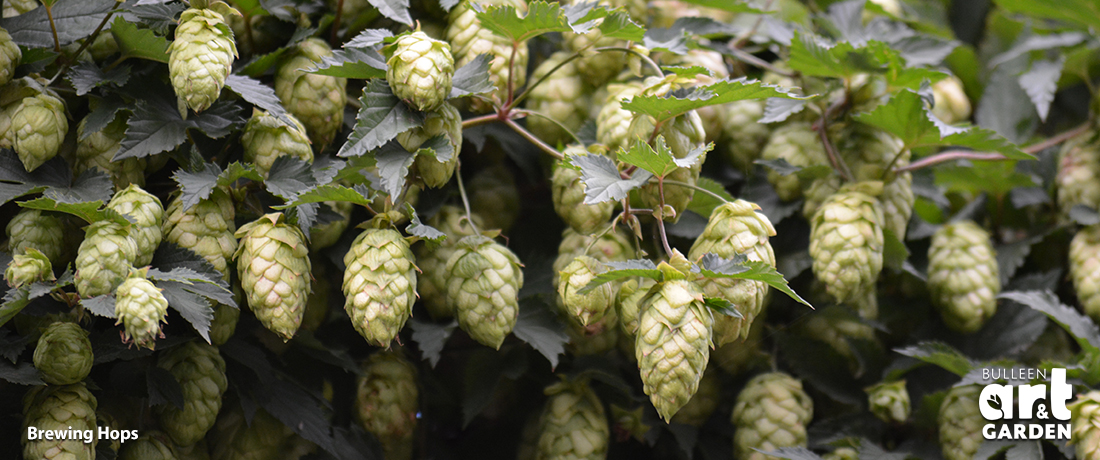
 Important note about plant availability. Important note about plant availability.There are hundreds of factsheets on our website provided for your information. Not all plants will be available at all times throughout the year. To confirm availability please call (03) 8850 3030 and ask for the nursery. |
Hops are the female flowers (looking like very small green pinecones) of the hop vine Humulus lupulus. It is a vigorous herbaceous perennial vine – and will scoot up quickly to several metres high in one year. It dies back each year over winter, but will quickly re-establish itself in spring and summer. Hops flower over summer and are ready to harvest in early to late autumn. One hop plant should produce enough for a home brewer, but two different types will give you a bit of variety to play with when brewing. Victoria is good hops growing country.
Planting hops
Choose a sunny position with lots of vertical space as the twining vine will rapidly climb over 5m up strings/wires/ropes. Improve the soil with manure and compost. If the soil is not very well drained then mound it up 30cm or more to make sure drainage is sufficient. Hop vines can be very heavy, so construct a trellis or wire system that is sturdy and can take 10kg or more of weight. Plant in spring, after the last frost.
Growing hops
Once the hops plant is shooting well, take the best few shoots and twine them up the trellis/wires, they will naturally want to go in an anticlockwise direction in the southern hemisphere, so encourage them in that direction. Trim the rest of the shoots off and let the plant put its energy into the shoots you have selected. These shoots are referred to as ‘bines’.
With such a large leaf mass, the water requirement is correspondingly large, regular deep watering is needed. Drip irrigation is ideal. They will need around 5L a day over the warmer months.
Harvesting hops
You will get some hops to harvest in year one, but the main harvests will come in the second and subsequent years. Hops tend to ripen sporadically, and are best harvested as they ripen rather than waiting for them all to be ripened and harvesting in one go.
To determine if the hop cones are ready to pick, press them and see if they are papery dry, springy and release a good strong ‘hoppy’ aroma. Plus they may leave a bit of yellow powder on your fingers. To confirm, split one open – it should be filled with a rich yellow powder.
Dry the cones in a shady spot (must be out of the sunlight) and when dry store out of sunlight sealed in a vacuum sealed bag. Can then be thrown in the freezer if you are not ready to use them.
Maintaining hops
After all cones have been harvested the bines can be cut back to a metre or so above ground level, or you can leave them in place, but once the first frost has killed them off, cut back to just above ground level and mulch around them. They will now rest over winter in preparation for doing it all again next spring.
Keep an eye on the rhizomes, they can spread and you don’t want hops taking over your garden!
Using hops
The hop flower is used as a flavouring agent in beer, as well as a preserving agent and assisting the foaming.
Can make tea out of the dried flower cones. Leave on vine as long as possible to dry. Brew one cone to around 1L of water. Makes a bitter digestive tea – VERY relaxing (from same family as marijuana).
Also steeped in alcohol such as Chartreuse or Vermouth, to make a digestif.
 Important note about plant availability. Important note about plant availability.There are hundreds of factsheets on our website provided for your information. Not all plants will be available at all times throughout the year. To confirm availability please call (03) 8850 3030 and ask for the nursery. |
Varieties of Hops
Cascade
An aroma type. Good for aroma and flavouring as well as bittering. Used for pale ales, and IPAs
Aroma Profile: Intense Floral/Citrus/Grapefruit/Spicy
Average Alpha Acids: 5.5-9.0% (moderate to high)
Chinook
For Pale Ales and IPAs
Aroma Profile: Spice/Pine/Grapefruit
Average alpha acids: 12-14%
Fuggle
Used for imparting a European aroma
Aroma profile: European
Average alpha acids: 2.5-6%
Goldings
Aroma Profile: Floral/Fruity/Herbal
Average alpha acids: 4.5%
Mount Hood
For aroma.
Aroma profile: Warm and clean. Mild herbal notes (fennel, tarragon) along with floral or lemony elements
Average alpha acids: 4-7%
Pride of Ringwood
Used by CUB to bitter all its beers. Strong aroma and earthy citrus flavour.
Aroma Profile: Cedar/Oak/Herbal
Average alpha acids: 9%
Highly disease resistant.
Red Earth
For aroma and some (limited) bittering
Aroma profile:spicy, woody aroma and flavor with a citrusy under note
Super Alpha
Dual purpose. For aroma and bittering
Aroma Profile: Herbal piney and lemongrass
Average alpha acids 10% -12%
Target
Aroma Profile: Citrus/Spicy
Average alpha acids: 9.5-12.5%
Vienna Gold
All round brewers hop
Württemberg (Tettnanger)
All round aroma and bittering hop
Average alpha acids: 3.5-5.5%
